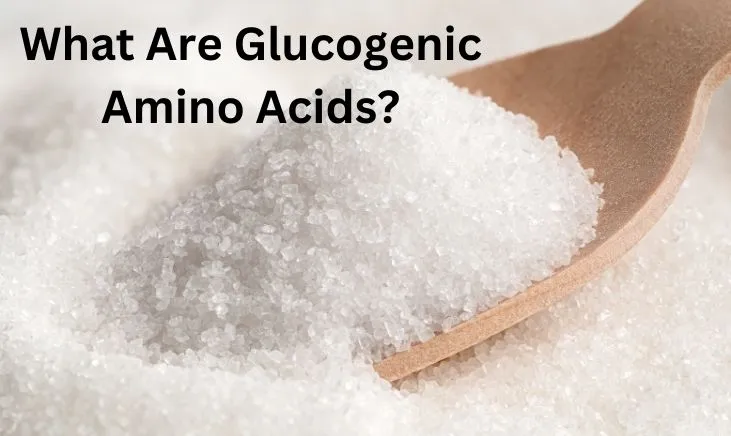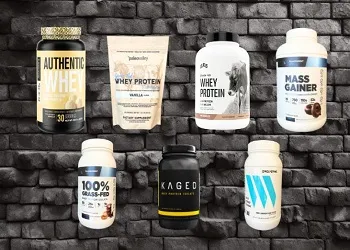Glucogenic amino acids, when metabolized, form pyruvate or an intermediate from the Krebs Cycle (citric acid cycle)—a-ketoglutarate, succinyl-CoA, fumarate, or oxaloacetate. The glucogenic amino acids include glycine, serine, threonine, valine, histidine, arginine, cysteine, proline, alanine, glutamate, glutamine, aspartate, asparagine, and methionine. Isoleucine, phenylalanine, tyrosine, and tryptophan can be glucogenic or ketogenic.
Quick Look
- Gluconeogenesis is the process of forming glucose from non-carbohydrate sources.
- Amino acids can be glucogenic, ketogenic, or both, depending on where they enter the metabolic pathway.
- Glucogenic amino acids produce pyruvate of any citric acid cycle intermediates, including a-ketoglutarate, succinyl-CoA, fumarate, or oxaloacetate.
- The glucogenic amino acids include glycine, serine, threonine, valine, histidine, arginine, cysteine, proline, alanine, glutamate, glutamine, aspartate, asparagine, and methionine.
Table of Contents
The Role of Glucose
Glucose is a simple sugar that serves as the primary fuel for several organs in the body. Many organs, even at rest, have a high energy demand, meaning they need a consistent supply of glucose to function. Glucose is the preferred fuel source because it’s rapidly broken down and utilized for energy.
This energy is created through a 10-step process called glycolysis.

During glycolysis, the following is produced:
- 2 pyruvate
- ATP (energy)
- NADH
- Water
In most cases, glycolysis produces sufficient energy to sustain normal functions, but gluconeogenesis ensures that, in the absence of glucose due to a low-carb diet, excessive exercise, or the like, adequate glucose levels can still be maintained.
Gluconeogenesis: Producing Glucose From Non-Carbohydrate Sources

Before we can understand what glucogenic amino acids are, it’s important to understand what gluconeogenesis is.
Under normal conditions, the body breaks down carbohydrates to produce glucose, fueling specific organs. However, some organs can only use glucose as metabolic fuel. This includes the brain, eyes, and kidneys. Because certain activities—prolonged fasting, strenuous exercise.—deplete glycogen stores, the body must switch to de-novo glucose synthesis to maintain blood glucose levels.
This happens via a process called gluconeogenesis, or the formation of glucose from non-hexose (non-carbohydrate) sources, specifically:
- Glycerol
- Lactate
- Pyruvate
- Propionate
- Glucogenic amino acids
Four enzymes facilitate glucose synthesis via gluconeogenesis, but because these enzymes aren’t present in all cell types, gluconeogenesis can only occur in some tissues. In humans, it occurs primarily in the liver and, to a lesser extent, the renal cortex (kidneys).
So, what triggers gluconeogenesis?
In most cases, low blood sugar and the diabetogenic hormones:
- Glucagon
- Growth hormone
- Epinephrine
- Cortisol
Key takeaway: Gluconeogenesis occurs primarily in the liver, where glucose is produced from amino acids, glycerol (the backbone of triglycerides), and glucose metabolism intermediaries, such as lactate and pyruvate.
Gluconeogenesis vs. Ketosis
Another differentiation we need to make is between gluconeogenesis and ketosis.
People on a low-carb diet are likely familiar with the metabolic state called ketosis; this is an alternative method of providing fuel when glucose levels are insufficient. But while ketosis and gluconeogenesis have some commonalities, they’re not the same.
- Ketosis is the metabolic state where the body burns fat instead of glucose for energy.
- Gluconeogenesis is the process of producing glucose from non-carbohydrate sources.
When you’re in a ketotic state, energy is supplied through ketone bodies circulating in the blood. Ketone bodies are produced through ketogenesis, which occurs in the mitochondria of hepatic (liver) cells.
Ketogenesis and gluconeogenesis are similar in that they produce energy when carbohydrates/glucose are lacking in the diet. However, ketogenesis results in ketones, whereas the end product of gluconeogenesis is glucose 6-phosphate; G6P can then be stored as glycogen or broken down into glucose in one final step.
What Are Glucogenic Amino Acids?

Now that you understand gluconeogenesis and how it differs from ketosis, we can turn to glucogenic amino acids.
Amino acids can be classified into two categories:
- Glucogenic
- Ketogenic
They are grouped based on the type of intermediates formed during amino acid catabolism.
- Glucogenic amino acids → produce pyruvate or one of the intermediates in the Krebs Cycle (a-ketoglutarate, succinyl-CoA, fumarate, or oxaloacetate)
- Ketogenic amino acids → produce acetyl CoA or acetoacetyl CoA
That begs the question, which amino acids are glucogenic and which are ketogenic?
Which Amino Acids Are Glucogenic?
Check out the table below for a breakdown of which amino acids fall into which category.
| Glucogenic | Glucogenic or Ketogenic | Ketogenic |
|---|---|---|
| Alanine | Isoleucine | Leucine |
| Arginine | Phenylalanine | Lysine |
| Aspartate | Tryptophan | |
| Asparagine | Tyrosine | |
| Cysteine | ||
| Glutamine | ||
| Glutamate | ||
| Glycine | ||
| Histidine | ||
| Methionine | ||
| Proline | ||
| Serine | ||
| Threonine | ||
| Valine |
Key takeaway: Glucogenic amino acids are broken down to produce pyruvate or one of the intermediates in the Krebs Cycle (a-ketoglutarate, succinyl-CoA, fumarate, or oxaloacetate). Ketogenic amino acids produce acetyl CoA or acetoacetyl CoA when broken down.
What’s the Point of Gluconeogenesis?
Gluconeogenesis is designed to maintain glucose levels and energy stores, specifically during starvation. Because some tissues in the human body rely almost exclusively on glucose as a fuel source, a consistent supply of glucose must be present regardless of the circumstances.
Ketones can also serve as an alternative fuel for the brain, but other organs—the testes, renal medulla, and erythrocytes—can’t survive long without sufficient amounts of glucose.
Gluconeogenesis generally starts four to six hours after fasting begins and peaks around 24 hours when hepatic glycogen is depleted.
Takeaway
Gluconeogenesis is an inherent process in the body that’s designed to produce glucose from non-carbohydrate sources, including glycerol, lactate, pyruvate, and propionate. Glucogenic amino acids—amino acids that break down into pyruvate or citric acid cycle intermediates—can also be used during gluconeogenesis. There are 14 glucogenic amino acids and two ketogenic amino acids, while the remaining four function as both ketogenic and glucogenic depending on the amino acid catabolism pathway.
Frequently Asked Questions
Which amino acids are glucogenic?
The glucogenic amino acids include glycine, serine, threonine, valine, histidine, arginine, cysteine, proline, alanine, glutamate, glutamine, aspartate, asparagine, and methionine. Isoleucine, phenylalanine, tyrosine, and tryptophan can be glucogenic or ketogenic.
Why are leucine and lysine not glucogenic?
Leucine and lysine are not glucogenic amino acids due to the products produced during metabolism. The products of amino acid catabolism do not form 3-carbon intermediates, like pyruvate, or 4-carbon compounds, like oxaloacetate, that can produce glucose.
What is the difference between ketogenic and glucogenic amino acids?
Glucogenic amino acids break down to yield oxaloacetate that produces glucose. In contrast, ketogenic amino acids enter a metabolic cycle to produce acetyl-CoA or acetoacetyl-CoA and ultimately produce ketone bodies.
What are the only two exclusively ketogenic amino acids?
Leucine and lysine are the only two exclusively ketogenic amino acids. The carbon skeletons of these two amino acids do not form intermediates in Krebs Cycle and are not substrates of gluconeogenesis and, therefore, do not yield glucose.














